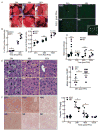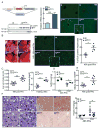Nicotinamide adenine dinucleotide biosynthesis promotes liver regeneration
- PMID: 27809334
- PMCID: PMC5258848
- DOI: 10.1002/hep.28912
Nicotinamide adenine dinucleotide biosynthesis promotes liver regeneration
Erratum in
-
Correction.Hepatology. 2017 Apr;65(4):1427. doi: 10.1002/hep.29101. Epub 2017 Mar 3. Hepatology. 2017. PMID: 28323369 No abstract available.
Abstract
The regenerative capacity of the liver is essential for recovery from surgical resection or injuries induced by trauma or toxins. During liver regeneration, the concentration of nicotinamide adenine dinucleotide (NAD) falls, at least in part due to metabolic competition for precursors. To test whether NAD availability restricts the rate of liver regeneration, we supplied nicotinamide riboside (NR), an NAD precursor, in the drinking water of mice subjected to partial hepatectomy. NR increased DNA synthesis, mitotic index, and mass restoration in the regenerating livers. Intriguingly, NR also ameliorated the steatosis that normally accompanies liver regeneration. To distinguish the role of hepatocyte NAD levels from any systemic effects of NR, we generated mice overexpressing nicotinamide phosphoribosyltransferase, a rate-limiting enzyme for NAD synthesis, specifically in the liver. Nicotinamide phosphoribosyltransferase overexpressing mice were mildly hyperglycemic at baseline and, similar to mice treated with NR, exhibited enhanced liver regeneration and reduced steatosis following partial hepatectomy. Conversely, mice lacking nicotinamide phosphoribosyltransferase in hepatocytes exhibited impaired regenerative capacity that was completely rescued by administering NR.
Conclusion: NAD availability is limiting during liver regeneration, and supplementation with precursors such as NR may be therapeutic in settings of acute liver injury. (Hepatology 2017;65:616-630).
© 2016 by the American Association for the Study of Liver Diseases.
Conflict of interest statement
R.W.D. is an employee and stockholder of Chromadex Inc., which manufactures and distributes NR. The remaining authors declare no conflicts of interest.
Figures






Similar articles
-
SIRT3 is required for liver regeneration but not for the beneficial effect of nicotinamide riboside.JCI Insight. 2021 Apr 8;6(7):e147193. doi: 10.1172/jci.insight.147193. JCI Insight. 2021. PMID: 33690226 Free PMC article.
-
Nicotinamide riboside, an NAD+ precursor, attenuates the development of liver fibrosis in a diet-induced mouse model of liver fibrosis.Biochim Biophys Acta Mol Basis Dis. 2019 Sep 1;1865(9):2451-2463. doi: 10.1016/j.bbadis.2019.06.009. Epub 2019 Jun 11. Biochim Biophys Acta Mol Basis Dis. 2019. PMID: 31195117 Free PMC article.
-
Nicotinamide riboside kinases display redundancy in mediating nicotinamide mononucleotide and nicotinamide riboside metabolism in skeletal muscle cells.Mol Metab. 2017 May 29;6(8):819-832. doi: 10.1016/j.molmet.2017.05.011. eCollection 2017 Aug. Mol Metab. 2017. PMID: 28752046 Free PMC article.
-
Balancing NAD+ deficits with nicotinamide riboside: therapeutic possibilities and limitations.Cell Mol Life Sci. 2022 Aug 2;79(8):463. doi: 10.1007/s00018-022-04499-5. Cell Mol Life Sci. 2022. PMID: 35918544 Free PMC article. Review.
-
A Narrative Review of Nicotinamide Adenine Dinucleotide (NAD)+ Intermediates Nicotinamide Riboside and Nicotinamide Mononucleotide for Keratinocyte Carcinoma Risk Reduction.J Drugs Dermatol. 2022 Oct 1;21(10):1129-1132. doi: 10.36849/JDD.6870. J Drugs Dermatol. 2022. PMID: 36219044 Review.
Cited by
-
The Effect of Diabetes Mellitus Type 1 on the Energy Metabolism of Hepatocytes: Multiphoton Microscopy and Fluorescence Lifetime Imaging.Int J Mol Sci. 2023 Nov 30;24(23):17016. doi: 10.3390/ijms242317016. Int J Mol Sci. 2023. PMID: 38069338 Free PMC article.
-
Cell cycle regulation in NAFLD: when imbalanced metabolism limits cell division.Hepatol Int. 2020 Jul;14(4):463-474. doi: 10.1007/s12072-020-10066-6. Epub 2020 Jun 22. Hepatol Int. 2020. PMID: 32578019 Free PMC article. Review.
-
Nicotinamide Riboside, a Promising Vitamin B3 Derivative for Healthy Aging and Longevity: Current Research and Perspectives.Molecules. 2023 Aug 15;28(16):6078. doi: 10.3390/molecules28166078. Molecules. 2023. PMID: 37630330 Free PMC article. Review.
-
Nicotinamide Riboside and Phycocyanin Oligopeptides Affect Stress Susceptibility in Chronic Corticosterone-Exposed Rats.Antioxidants (Basel). 2023 Oct 12;12(10):1849. doi: 10.3390/antiox12101849. Antioxidants (Basel). 2023. PMID: 37891928 Free PMC article.
-
Aminodihydrophthalazinedione Sodium Transdermal Therapeutic System Specific Activity on an ExperimentalModel of Extensive Liver Resection.Life (Basel). 2023 Feb 27;13(3):658. doi: 10.3390/life13030658. Life (Basel). 2023. PMID: 36983814 Free PMC article.
References
-
- Fan ST, Lo CM, Liu CL, et al. Safety of donors in live donor liver transplantation using right lobe grafts. Arch Surg. 2000;135:336–40. - PubMed
-
- Kubota K, Makuuchi M, Kusaka K, et al. Measurement of liver volume and hepatic functional reserve as a guide to decision-making in resectional surgery for hepatic tumors. Hepatology. 1997;26:1176–81. - PubMed
MeSH terms
Substances
Grants and funding
LinkOut - more resources
Full Text Sources
Other Literature Sources

